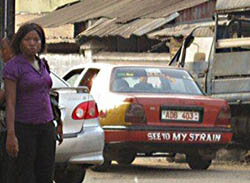 |
Although in local Sierra Leonean Pidgin "see to my strain" does not have anything to do with rhizobia and inoculation, this text on the back of a car in Freetown nicely covered the purpose of our trip to Sierra Leone and Liberia, where N2Africa is currently expanding with additional funding from the H.G. |

